Mitigation
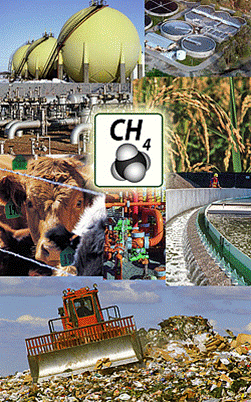
Climate Emergency Institute
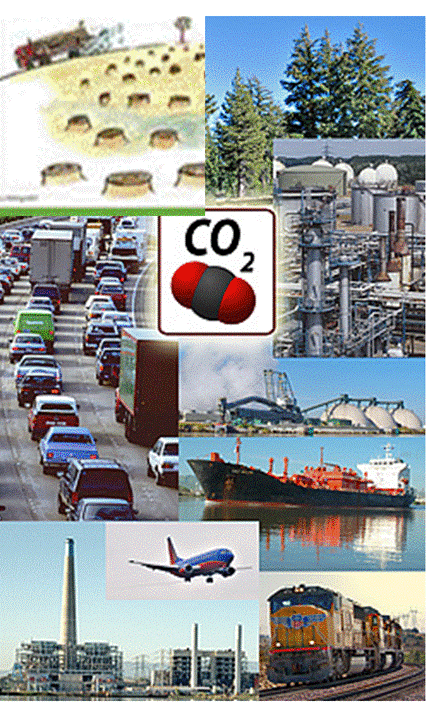
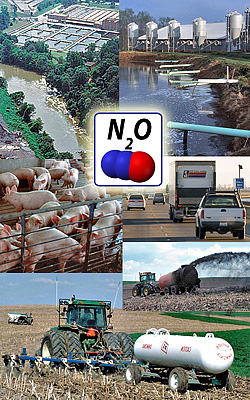
CO2 removal (CDR)
The IPCC 6th Assessment says CDR is a 'mitigation option'. It's not because today after years of trying there is no capacity for removal that would affect atmos[heric CO2 at all, and there is still nothing in sight.
IPCC AR6 WG1 Science says D.1.4 'Anthropogenic CO2 removal (CDR) has the potential to remove CO2 from the atmosphere and durably store it in reservoirs
The IPCC 6th Assessment says CDR is a 'mitigation option'. It's not because today after years of trying there is no capacity for removal that would affect atmos[heric CO2 at all, and there is still nothing in sight.
IPCC AR6 WG1 Science says D.1.4 'Anthropogenic CO2 removal (CDR) has the potential to remove CO2 from the atmosphere and durably store it in reservoirs
(high confidence). CDR aims to compensate for residual emissions to reach net zero CO2 or net zero GHG emissions' D.1.5 'Anthropogenic CO2 removal (CDR) leading to global net negative emissions would lower the atmospheric CO2 concentration
and reverse surface ocean acidification'
WG 3 SPM C.4.6 CCS is 'an option to reduce emissions from large-scale fossil-based energy and industry sources, provided geological storage is available. When CO2 is captured directly from the atmosphere (DACCS), or from biomass (BECCS), CCS provides the storage component of these CDR methods'.
'The technical geological CO2 storage capacity is estimated to be on the order of 1000 GtCO2, which is more than the CO2 storage requirements through 2100 to limit global warming to 1.5°C, although the regional availability of geological storage could be a limiting factor'
Yet IPCC AR6 does not have the end of the fossil industry as a mitigation essential-
WG 3 SPM C.4.6 CCS is 'an option to reduce emissions from large-scale fossil-based energy and industry sources, provided geological storage is available. When CO2 is captured directly from the atmosphere (DACCS), or from biomass (BECCS), CCS provides the storage component of these CDR methods'.
'The technical geological CO2 storage capacity is estimated to be on the order of 1000 GtCO2, which is more than the CO2 storage requirements through 2100 to limit global warming to 1.5°C, although the regional availability of geological storage could be a limiting factor'
Yet IPCC AR6 does not have the end of the fossil industry as a mitigation essential-
it has to be by the science.
Civil society in general on principle to geoengineering for planet cooling and for CO2 removal except direct air capture.
Research was published by Environmental Research Letters 2018 Special issue Focus on Negative Emissions
IPCC says 'Non geoengineering safe effective CDR includes regenerative agriculture, biochar, CDR geo-engineering methods are not mature technologies and all sources conclude their practical value at scale to be questionable'.
The most published CDR method is bioenergy + carbon capture sequestration (BECCS). There are potential direct air capture technologies (DAC) but the IPCC treats these as too expensive.
Many IPCC reports address CDR.
2011 IPCC Expert Meeting on Geoengineering.
Springer in 2013 published a special issue on -ve emissions.
A comprehensive IPCC section was in 2014 AR5 WG3 11.13 Appendix Bioenergy.
2017 review showed that even after many years of consideration CDR has made no real progress.
A report,(Feb 2018) is on the UN Climate Sec site by the European Academies Science Advisory Council, which does not support BECCS and concludes 'these technologies offer only limited realistic potential to remove carbon from the atmosphere' .. 'and not at the levels required to compensate for inadequate mitigation'. T
CDR theoretical potentials have been published nevertheless.
Methods at this time do need to to be tried as part of the planetary emergency response but assumed effectiveness should not be relied for mitigation policy.
Despite being included in many models and mitigation papers, it therefore remains unknown if CCS, BECCS or DAC are feasible. We have to assume they will not stop ocean heating, acidification and deoxygenation. As the oceans are the ultimate determinant of climate this makes the Earth emergency doubly dire.
We need a planet emergency global massive Manhattan model project.
Research was published by Environmental Research Letters 2018 Special issue Focus on Negative Emissions
IPCC says 'Non geoengineering safe effective CDR includes regenerative agriculture, biochar, CDR geo-engineering methods are not mature technologies and all sources conclude their practical value at scale to be questionable'.
The most published CDR method is bioenergy + carbon capture sequestration (BECCS). There are potential direct air capture technologies (DAC) but the IPCC treats these as too expensive.
Many IPCC reports address CDR.
2011 IPCC Expert Meeting on Geoengineering.
Springer in 2013 published a special issue on -ve emissions.
A comprehensive IPCC section was in 2014 AR5 WG3 11.13 Appendix Bioenergy.
2017 review showed that even after many years of consideration CDR has made no real progress.
A report,(Feb 2018) is on the UN Climate Sec site by the European Academies Science Advisory Council, which does not support BECCS and concludes 'these technologies offer only limited realistic potential to remove carbon from the atmosphere' .. 'and not at the levels required to compensate for inadequate mitigation'. T
CDR theoretical potentials have been published nevertheless.
Methods at this time do need to to be tried as part of the planetary emergency response but assumed effectiveness should not be relied for mitigation policy.
Despite being included in many models and mitigation papers, it therefore remains unknown if CCS, BECCS or DAC are feasible. We have to assume they will not stop ocean heating, acidification and deoxygenation. As the oceans are the ultimate determinant of climate this makes the Earth emergency doubly dire.
We need a planet emergency global massive Manhattan model project.
Renewable energy can repower the world according to the IPCC in its 2011 renewable energy report that all fossil fuel energy could be replaced by renewable energies, for an investment of 1% of global GDP or $5 over the next decade. This is the same as governments have been giving to the fossil fuel industries in subsidies (IMF 2015).
The Burning Age is over and the only solution to carbon pollution is conversion to a (virtual) zero carbon clean renewable energy economy
Zero carbon means zero deforestation, plus global afforestation
The fossil fuel industry hs pushed our planet is on the brink of runaway climate change - total planetary catastrophe.
We have to convert our industrial GHG polluting world to a non GHG polluting one and fast. An immediate International Planetary Emergency Manhattan Marshall Model Venture is now the only survival response — primarily for a big upgrade of our new clean energy technologies and to get safe, zero-combustion, super high energy density safe new fission on line. And we need safe direct air CO2 removal to get near zero CO2 emissions (not by burning biomass).
For energy/power density, see Vaclav Smil and IPCC renewable energy report, SREEN.
ALL fossil fuel energy must be replaced by clean virtual zero carbon ever lasting energy. That is because of the definite science of zero carbon emissions, without which global temperature and ocean acidification cannot stabilize
Our site Zero carbon science
Our site Zero carbon science
Renewable energy can repower the world according to the IPCC in its 2011 renewable energy report that all fossil fuel energy could be replaced by renewable energies, for an investment of 1% of global GDP or $5 over the next decade. This is the same as governments have been giving to the fossil fuel industries in subsidies (IMF 2015).
The Burning Age is over and the only solution to carbon pollution is conversion to a (virtual) zero carbon clean renewable energy economy
Zero carbon means zero deforestation, plus global afforestation
The fossil fuel industry hs pushed our planet is on the brink of runaway climate change - total planetary catastrophe.
We have to convert our industrial GHG polluting world to a non GHG polluting one and fast. An immediate International Planetary Emergency Manhattan Marshall Model Venture is now the only survival response — primarily for a big upgrade of our new clean energy technologies and to get safe, zero-combustion, super high energy density safe new fission on line. And we need safe direct air CO2 removal to get near zero CO2 emissions (not by burning biomass).
For energy/power density, see Vaclav Smil and IPCC renewable energy report, SREEN.
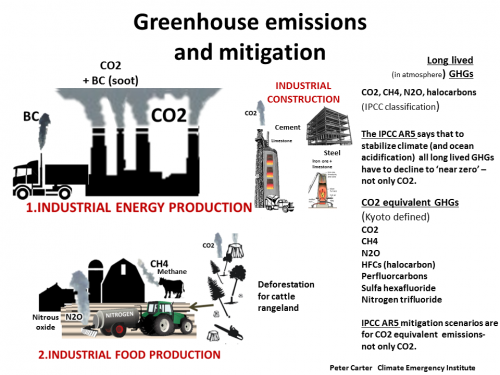
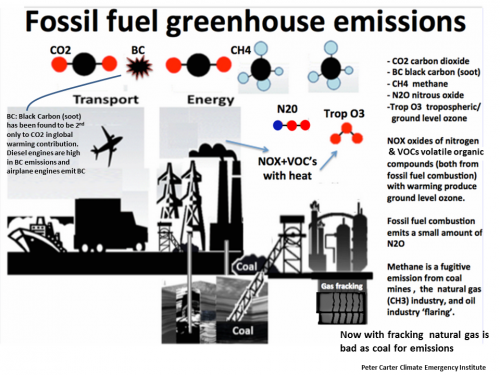
Food production 30% emissions
From 2012 published research world food production is now responsible for 30% of global GHG emissions. This requires stopping forestation for agricultural land, conversion off the meat heavy diet to 100% plant based
End livestock meat industry which is a major increasing source o methane emissions
Wetland rice cultivation if a major increasing source of methane
Because of unavoidable CO2 emissions from our best food production, the best we do to stop adding CO2 is energy conversion is virtual zero carbon (90% reduction of CO2 emissions) which requires some CO2 removal
From 2012 published research world food production is now responsible for 30% of global GHG emissions. This requires stopping forestation for agricultural land, conversion off the meat heavy diet to 100% plant based
End livestock meat industry which is a major increasing source o methane emissions
Wetland rice cultivation if a major increasing source of methane
Because of unavoidable CO2 emissions from our best food production, the best we do to stop adding CO2 is energy conversion is virtual zero carbon (90% reduction of CO2 emissions) which requires some CO2 removal
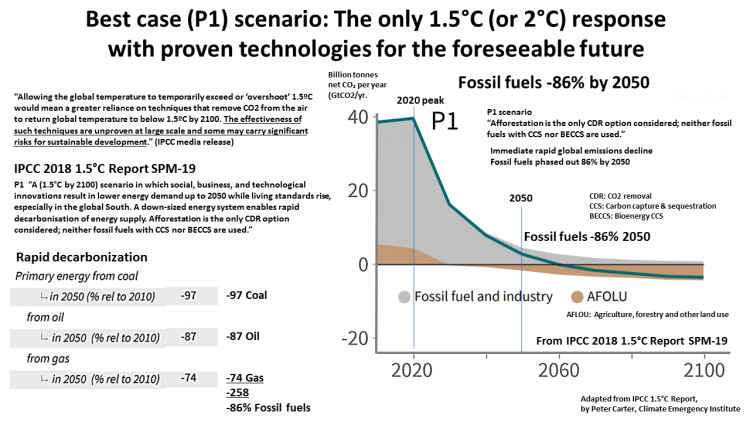
A decade to end fossil fuels 2016 study
In its 2019 Emissions GAP Report the UNEP said (again) emissions had to decline by 2020 UNEP 2019 GLOBAL EMISSIONS MUST DROP 7.6%/ YEAR from 2020. UNEP had called for the 2020 emissions decline at the latest in its 2022 Gap Report- for the 2°C limit. UNEP had called for global emissions to decline by 2020 at the very least years ago in its 2011 Gap Report.
Jan 2020 'We Need a Massive Climate War Effort—Now Only major spending on clean energy R&D can save us'. Massive Manhattan Project type R&D
VIDEO 2021. IPCC Chair H. Lee at the 2021 UN COP26 says Global emissions must decline immediately for 1.5°C & 2°C

Oct 2020 FoE. Net zero fraud
Open ended Net zero, (not defined as today) is a misleading chimera
It depends on unspecified so unlimited CO2 removal (see below)
3 May 2021 Dangerous Trap
11 Dec 2020 net zero busted
It depends on unspecified so unlimited CO2 removal (see below)
3 May 2021 Dangerous Trap
11 Dec 2020 net zero busted
11 May 2021. De-growth is now a must and with investment only going to zero combustion low GHG emissions development.
Double click here to edit this text.
Today (2023) global emissions of all GHGs are higher than ever and still increasing as fast as ever.
For years the IPCC and climate science have said global emissions must be in decline by 2020 at the very latest. The 2007 AR4 had 2015 as the time limit for 2°C.
The 2018 IPPC 1.5°C Report and UNEP called for
halving emissions reduction by 2030
The IPCC AR6 (WG3) called for IMMEDIATE rapid reduction in global emissions.
Opposite is the IPCC AR6 table on energy changes
by 2023 and 2050 for 1.5°C and 2°C by 2100.
For 1.5°C CO2 emissions are -50% and 2050 -100%
Coal is cut 75% 2030 and 95% by 2050
The IPCC has made it clear in 2014 that fossil fuel combustion must end. Mitigation "pathways
For years the IPCC and climate science have said global emissions must be in decline by 2020 at the very latest. The 2007 AR4 had 2015 as the time limit for 2°C.
The 2018 IPPC 1.5°C Report and UNEP called for
halving emissions reduction by 2030
The IPCC AR6 (WG3) called for IMMEDIATE rapid reduction in global emissions.
Opposite is the IPCC AR6 table on energy changes
by 2023 and 2050 for 1.5°C and 2°C by 2100.
For 1.5°C CO2 emissions are -50% and 2050 -100%
Coal is cut 75% 2030 and 95% by 2050
The IPCC has made it clear in 2014 that fossil fuel combustion must end. Mitigation "pathways
would require substantial emissions reductions over the next few decades and near zero emissions of carbon dioxide and other long-lived greenhouse gases"
IPCC 2014 AR5
IPCC 2014 AR5
For any chance to "secure a liveable future" (IPCC AR6) emissions have to decline "immediately" (IPCC AR6). The IPCC Chair first called for this immediate emissions decline Dec. 2021 at UN COP25 "Our assessments show that climate stabilization implies that
greenhouse gas emissions must start to peak from next year".
This was last repeated by the IPCC Chair at the 2023 COP28 (30 Nov, 2023)
"Without immediate and deep emissions reductions across all sectors, we will not meet the goals of the Paris Agreement.The UNEP Gap Report released a few days ago shows that we are headed towards global warming of 3 degrees C if we carry on with current policies". (IPCC Chair, Jim Skea)
That means without immediate deep emissions reductions, global warming will not be limited to 2°C, let alone 1.5°C. It will increase to 3°C. From the IPCC AR6 globall disastrous 1.5°C will be in "the early 2030s" and 2C by 2050
Paris Agreement, Article 2, 1 (a) Holding the increase in the global average temperature to well below 2 °C above pre-industrial levels and pursuing efforts to limit the temperature increase to 1.5 °C above pre-industrial levels, recognizing that this would significantly reduce the risks and
Incredibly this survival message of immediacy has not got out- at all, and is not being put out, even by the scientists.
"Without immediate and deep emissions reductions across all sectors, we will not meet the goals of the Paris Agreement.The UNEP Gap Report released a few days ago shows that we are headed towards global warming of 3 degrees C if we carry on with current policies". (IPCC Chair, Jim Skea)
That means without immediate deep emissions reductions, global warming will not be limited to 2°C, let alone 1.5°C. It will increase to 3°C. From the IPCC AR6 globall disastrous 1.5°C will be in "the early 2030s" and 2C by 2050
Paris Agreement, Article 2, 1 (a) Holding the increase in the global average temperature to well below 2 °C above pre-industrial levels and pursuing efforts to limit the temperature increase to 1.5 °C above pre-industrial levels, recognizing that this would significantly reduce the risks and
impacts of climate change;
Incredibly this survival message of immediacy has not got out- at all, and is not being put out, even by the scientists.
All it requires to get started in the right direction is the immediate unconditional termination of all fossil fuel and all other GHG polluting subsidies by governments.
Fossil Fuel Subsidies Surged to Record $7 Trillion last year as governments supported consumers and businesses (24 August 2023, IMF)
Emissions will keep increasing otherwise, which means unprecedented ever increasing hardship and suffering, and the end of the world for humanity.
Citizens have to oppose big economy governments, big fossil fuel corporations and big banks that are determined to keep the world dependant on fossil fuels, and increasing emissions to continue which is an unprecedented evil.
On 2021 the IEA International Energy Agency published its IEA Net Zero Emissions by 2050. Surprisingly this is only detailed calculated plan by a relevant institution, though
it only covers energy.
Fossil Fuel Subsidies Surged to Record $7 Trillion last year as governments supported consumers and businesses (24 August 2023, IMF)
Emissions will keep increasing otherwise, which means unprecedented ever increasing hardship and suffering, and the end of the world for humanity.
Citizens have to oppose big economy governments, big fossil fuel corporations and big banks that are determined to keep the world dependant on fossil fuels, and increasing emissions to continue which is an unprecedented evil.
On 2021 the IEA International Energy Agency published its IEA Net Zero Emissions by 2050. Surprisingly this is only detailed calculated plan by a relevant institution, though
it only covers energy.
NET ZERO Net-zero has taken over all mitigation discussion
Net zero emissions (unspecified as today) and carbon neutral mean nothing for rapid mitigation.
It has to be by zero fossil fuel combustion and zero carbon combustion (no wood pellet/biomass power production, no biofuels, no cement-burning limestone)). The fossil industry has to end, replaced by 100% clean renewable energy.
Unqualified net zero, that even the fossil fuel corporations favour, is another way to delay mitigation and keep burning fossil fuels
Net zero emissions (unspecified as today) and carbon neutral mean nothing for rapid mitigation.
It has to be by zero fossil fuel combustion and zero carbon combustion (no wood pellet/biomass power production, no biofuels, no cement-burning limestone)). The fossil industry has to end, replaced by 100% clean renewable energy.
Unqualified net zero, that even the fossil fuel corporations favour, is another way to delay mitigation and keep burning fossil fuels
The 2018 IPCC 1.5°C Report best- case for 1.5°C had fossil fuel energy production down to near zero by 2050, specified by fuel
(see on image)
(see on image)
No more carbon
Zero fossil fuels
Stabilization of all long lived atmospheric GHGs (IPCC includes methane) is required to halt global warming and ocean heating
As has been know for many years Stabilization of climate (and oceans) requires no more carbon added to the atmosphere. This is due to the very long lifetime of atmospheric CO2 (hundreds of years) and the ocean thermal inertia
See our site Zero carbon science
So only phasing out fossil fuels 100% (fast) can stabilize atmospheric CO2
With 14 million yr. high CO2 level- this is obvious
Zero fossil fuels
Stabilization of all long lived atmospheric GHGs (IPCC includes methane) is required to halt global warming and ocean heating
As has been know for many years Stabilization of climate (and oceans) requires no more carbon added to the atmosphere. This is due to the very long lifetime of atmospheric CO2 (hundreds of years) and the ocean thermal inertia
See our site Zero carbon science
So only phasing out fossil fuels 100% (fast) can stabilize atmospheric CO2
With 14 million yr. high CO2 level- this is obvious
The Mitigation target has to be "near zero emissions" of CO2, methane, nittrous oxide and F-gases
See methane and nitrous oxide mitigation projections above
To limit warming to below 2°C relative to pre-industrial levels ...would require substantial emissions reductions over the next few decades and near zero emissions of carbon dioxide and other long-lived greenhouse gases by the end of the century (IPCC classifies methane as long lived).
(IPCC 2014 AR5, Synthesis Headline statements)
See methane and nitrous oxide mitigation projections above
To limit warming to below 2°C relative to pre-industrial levels ...would require substantial emissions reductions over the next few decades and near zero emissions of carbon dioxide and other long-lived greenhouse gases by the end of the century (IPCC classifies methane as long lived).
(IPCC 2014 AR5, Synthesis Headline statements)
End Deforestation
Stabilizing CO2 and zero combustion. requires the termination of deforestation, which is a significant source of CO2 emissions (12-20%)
Stabilizing CO2 and zero combustion. requires the termination of deforestation, which is a significant source of CO2 emissions (12-20%)

Most recent mitigation from
UN Climate Secretariat
UN Climate Secretariat
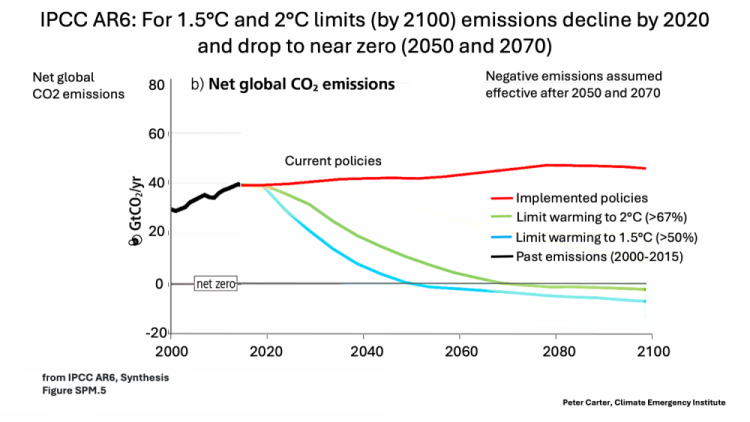
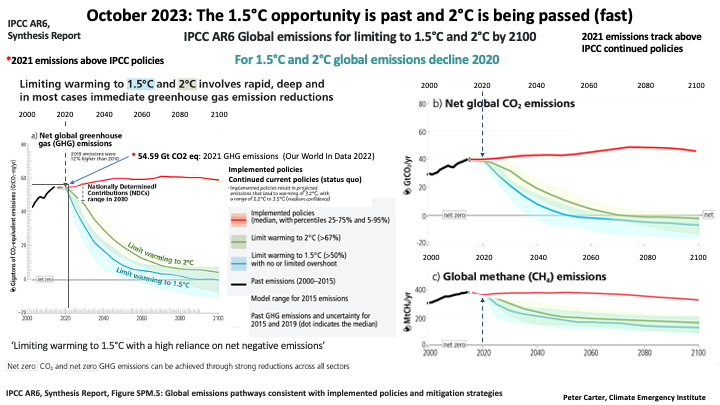
Energy consumption
World over-all energy use has to decline for global emissions to drop to near zero
All IPCC scenarios (including mitigation) assume continued economic growth, making rapid decline unfeasible.
World over-all energy use has to decline for global emissions to drop to near zero
All IPCC scenarios (including mitigation) assume continued economic growth, making rapid decline unfeasible.
In fact the 2020 emissions deadline (for 2°C) goes back to the 2007 IPCC 4th Assessment, and has been repeated since, by numerous papers and reports
Transition.Fossil fuel transition is the right word on mitigation, but it is undefined and it's not being linked to immediate emissions decline. It has to be 100%
GHG emissions sources
To plan for near zero knowledge of GHG emissions is needed
To plan for near zero knowledge of GHG emissions is needed
UNMITIGATED
Today 2024, 30 years after the UN climate change convention climate change remains unmitigated There are no science based all-GHG emissions mitigation plans. The UNEP Production Gap showed by 2030, plans of world governments produce 110% more fossil fuels than 1.5°C, and 69% more than 2°C.
Today 2024, 30 years after the UN climate change convention climate change remains unmitigated There are no science based all-GHG emissions mitigation plans. The UNEP Production Gap showed by 2030, plans of world governments produce 110% more fossil fuels than 1.5°C, and 69% more than 2°C.
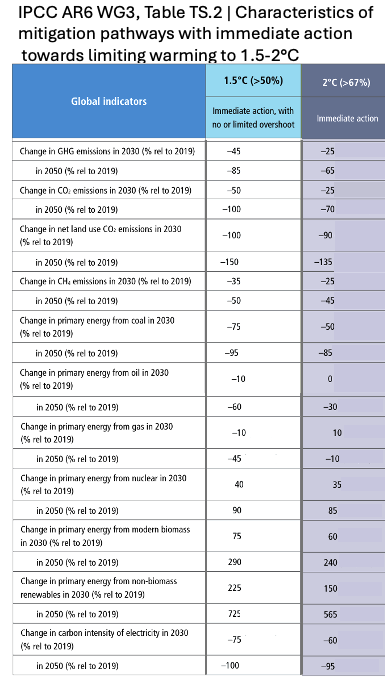
UN Climate Sec. Dec. 2023 estimates of emissions for 1.5°C and 2°C limits by 2100
IPCC AR6 mitigation table of energy changes for
1.5°C and 2°C
1.5°C and 2°C
There are carbon mitigation ideas that been around for years but cannot help long term stabilization (or oceans) because of carbon cycle science Our carbon site
IPCC 6th Assessment
Fission High energy dense nuclear fission power is required in the zero carbon energy mix- for heavy industry its fission or coal. Coal is top source of power today
Mitigation is zeroing human emissions, more than reducing
The Global warming limit being targeted since the 2015
Paris Agreement is 1.5°C
At Dec. 2023 COP 28 the mitigation science on emissions
(IPCC AR6) was adopted.
The Global warming limit being targeted since the 2015
Paris Agreement is 1.5°C
At Dec. 2023 COP 28 the mitigation science on emissions
(IPCC AR6) was adopted.
"Global greenhouse gas emissions are to peak between
2020 at the latest before 2025", by "deep, rapid and sustained reductions in global greenhouse gas emissions
of 43% by 2030 and 60% by 2035"
(2023, Global Stocktake outcome)
Note this methane and nitrous oxide as well as CO2
2020 at the latest before 2025", by "deep, rapid and sustained reductions in global greenhouse gas emissions
of 43% by 2030 and 60% by 2035"
(2023, Global Stocktake outcome)
Note this methane and nitrous oxide as well as CO2
Agreed to Dec. 2023 COP 28
"Global greenhouse gas emissions are to peak between 2020 at the latest before 2025", by "deep, rapid and sustained reductions in global greenhouse gas emissions of 43% by 2030 and 60% by 2035. (Under the Global Stocktake)

See IPCC AR6 below
Climate scenarios should based on emissions peak Sept. 2019, A new scenario logic for the Paris Agreement long-term temperature goal, Joeri Rogelj et al
Military Sector is a huge source of emissions (5-6%) but not counted in assessments and policy
Solutions Project (Prof Mark Jabobson)
100% solar-wind-water
100% solar-wind-water